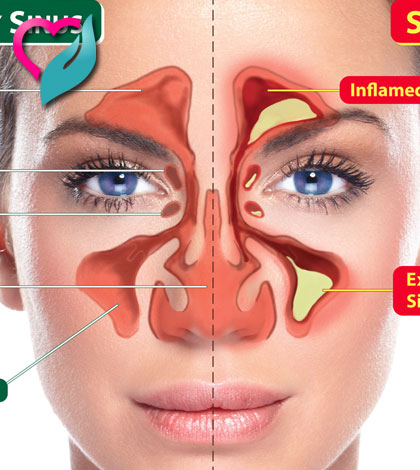Running nose, headache and sneezing are the most common irritating problems generally seen to people of all ages during winter season… Sinusitis are the most common irritating problem seen this season..
[wp_ad_camp_1]
Sinusitis is an inflammation, or swelling, of the tissue lining the sinuses. Normally, sinuses are filled with air, but when sinuses become blocked and filled with fluid, germs (bacteria, viruses, and fungi) can grow and cause an infection.
Conditions that can cause sinus blockage include the common cold, allergic rhinitis(swelling of the lining of the nose), nasal polyps (small growths in the lining of the nose), or a deviated septum (a shift in the nasal cavity)
[wp_ad_camp_4]
There are different types of sinusitis, including:
- Acute sinusitis: A sudden onset of cold-like symptoms such as runny, stuffy nose and facial pain that does not go away after 10 to 14 days. Acute sinusitis typically lasts 4 weeks or less.
- Subacute sinusitis: An inflammation lasting 4 to 8 weeks.
- Chronic sinusitis: A condition characterized by sinus inflammation symptoms lasting 8 weeks or longer.
- Recurrent sinusitis: Several attacks within a year.
[wp_ad_camp_2]
Who Gets Sinusitis?
About 2 crores people all around the world suffer from at least one episode of sinusitis each year. People who have the following conditions have a higher risk of sinusitis:
- Nasal mucous membrane swelling as from a common cold
- Blockage of drainage ducts
- Structural differences that narrow the drainage ducts
- Nasal polyps
Conditions that result in an increased risk of infection such as immune deficiencies or taking medications that suppress the immune system.In children, common environmental factors that contribute to sinusitis include allergies, illness from other children at day care or school, pacifiers, bottle drinking while lying on one’s back, and smoke in the environment,
In adults, the contributing factors are most frequently infections and smoking
What Are the Signs and Symptoms of Acute Sinusitis?
Some of the primary symptoms of acute sinusitis include:
- Facial pain/pressure
- Nasal stuffiness
- Nasal discharge
- Loss of smell
- Cough/congestion
Additional symptoms may include:
- Fever
- Bad breath
- Fatigue
- Dental pain
Acute sinusitis may be diagnosed when a person has two or more symptoms and/or the presence of thick, green, or yellow nasal discharge.
What Are the Signs and Symptoms of Chronic Sinusitis?
People with chronic sinusitis may have the following symptoms for 8 weeks or more:
- Facial congestion/fullness
- A nasal obstruction/blockage
- Pus in the nasal cavity
- Fever
- Nasal discharge/discolored postnasal drainage
Additional symptoms of chronic sinusitis may include:
- Headaches
- Bad breath
- Fatigue
- Dental pain
How Is Sinusitis Diagnosed?
To diagnose sinusitis, your doctor will review your symptoms and give you a physical examination.
The exam may include the doctor feeling and pressing your sinuses for tenderness. He or she may also tap your teeth to see if you have an inflamed paranasal sinus.
Other diagnostic tests to assess the potential causes for sinusitis may include a mucus culture, nasal endoscopy (see below), X-rays, allergy testing, CT scan of the sinuses, or blood work.
How Is Sinusitis Treated?
Treatment for sinusitis depends on the severity.
- Acute sinusitis. If you have a simple sinus infection, your health care provider may recommend treatment with decongestants like Sudafed and steam inhalations alone. Use of nonprescription decongestant nasal drops or sprays may also be effective in controlling symptoms. However, these medicines should not be used beyond their recommended use, usually four to five days, or they may actually increase congestion. If antibiotics are given, they are usually given for 10 to 14 days. With treatment, the symptoms usually disappear and antibiotics are no longer required.
- Chronic sinusitis. Warm moist air may alleviate sinus congestion. A vaporizer or inhaling steam from a pan of boiling water (removed from heat) may also help. Warm compresses are useful to relieve pain in the nose and sinuses. Saline nose drops are also safe for home use. Use of nonprescription decongestant nasal drops or sprays might be effective in controlling symptoms; however, they should not be used beyond their recommended use. Antibiotics or oral steroids may also be prescribed.
Other Treatment Options for Sinusitis
Addressing potential triggers or contributing factors is a key first step in the management of sinusitis. To reduce congestion due to sinusitis, your doctor may prescribe nasal sprays (some may contain steroid sprays), nose drops, or oral decongestant medicine. If you suffer from severe chronic sinusitis, oral steroids might be prescribed to reduce inflammation — usually only when other medications have not worked. Antibiotics will be prescribed for any bacterial infection found in the sinuses (antibiotics are not effective against a viral infection). An antihistamine may be recommended for the treatment of allergies. Antifungal medicine may be prescribed for a fungal sinus infection. Immunoglobulin (antibodies) may be given if you have certain immune deficiencies.
[wp_ad_camp_3]
Image courtesy : bp.blogspot.com , naturaltherapypages.com , handbagfairy.co.uk





























